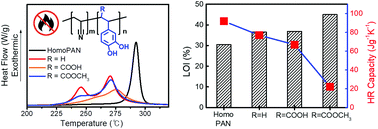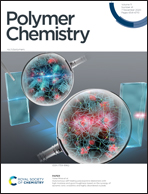Highly efficient halogen-free flame retardants of thermally-oxidized polyacrylonitrile copolymers containing bio-derived caffeic acid derivatives†
Abstract
Polyacrylonitrile (PAN) is utilized as a precursor for the production of high-performance flame retarding fibers and is also widely used for clothing fibers. Herein, we report the flame retarding properties of catechol-containing PAN copolymers. The comonomer, dihydroxy styrene (DHS), was prepared from bio-derived caffeic acid (CA), which is a key intermediate in the biosynthesis of lignin. P(AN-co-DHS) and P(AN-co-CA) were synthesized by free radical polymerization. The effect of the comonomer structure on the stabilization of PAN copolymers was studied by differential scanning calorimetry, Fourier-transform infrared spectroscopy, and thermogravimetric analysis. The catechol and acid groups of P(AN-co-DHS) and P(AN-co-CA) are effective at lowering the activation energy (Ea) for cyclization of the AN through an ionic mechanism. In CA copolymers, the acid-protected poly(acrylonitrile-co-methyl caffeate) (P(AN-co-MCA)) was found to be the most efficient in terms of Ea, the extent of reaction, and char fraction. The microscale combustion calorimetric analysis after thermal treatment (300 °C, 3 min) showed that the limiting oxygen index and heat release capacity of the P(AN-co-MCA3) fiber were approximately 45% with V-0 of UL rating (superior to Nomex®) and 63 J g−1 K−1, respectively. This research demonstrates a simple, sustainable methodology for the production of environmentally friendly and high-performance flame retardants.



 Please wait while we load your content...
Please wait while we load your content...